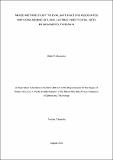Mixed method study to evaluate factors associated with discarding of long-lasting insecticidal nets in Bagamoyo, Tanzania
Abstract
Between 2000 and 2019, more than 1.8 billion long-lasting insecticidal nets (LLINs)were
distributed in Africa. While the insecticidal durability of LLINs is around 3 years, nets are
generally discarded 2 years post-distribution. This study investigated the factors associated
with the decision of users to discard LLINs. A mixed-methods sequential explanatory approach
using a structured questionnaire followed by focus group discussions (FGDs) was used to
collect information on experiences, views, reasons, how and when LLINs are discarded as well
as gather knowledge on net care and repair from the participants. Out of 6,526 households that
responded to the questionnaire of LLINs durability trial, 160 households were randomly
selected from the households in four villages in Bagamoyo Tanzania for FGDs but only 155
households participated in the FGDs. Five of the household representatives couldn’t participate
due to unexpected circumstances. A total of sixteen FGDs each comprising of 8-10 adults were
conducted; older women (40–60 years), older men (40-60 years), younger women (18-39
years), and younger men (18-39 years). During the FGDs, participants visually inspected seven
samples of LLINs that were “too-torn” based on the proportionate hole Index (PHI)
recommended by the World Health Organization guidelines on LLIN testing, the nets were
brought to the discussion, and participants had to determine if such LLINs were to be kept or
discarded. The study assessed responses from the same participants that attended FGD and also
responded to the structured questionnaire, 117 participants fulfilled the criteria, thus data from
only 117 participants are analyzed in this study. In FGDs, the Physical condition of LLIN
influenced the decision to discard or keep a net. Those of older age, women and householders
with lower income were more likely to classify a WHO “too-torn” net as “good”. The common
methods used to discard LLINs were burning and burying. The findings were seen in the
quantitative analysis. For every additional hole, the odds of discarding a WHO “too-torn” LLIN
increased [OR=1.05 (95%CI (1.04 – 1.07)), p<0.001]. Younger age group [OR=4.97 (95%CI
(3.25 – 7.32)), p<0.001], male-headed households [OR=6.85 (95%CI (4.44 –10.59)), p<0.001],
and wealthy households [OR=3.88 (95%CI (2.33 – 6.46)), p<0.001] were more likely to discard
LLINs: Physical condition of LLINs was the main determinant for discarding or keeping LLINs
and the decision to discard the net is associated with the socioeconomic status of the household,
and the age and gender of respondents. WHO “too torn” nets are encouraged to be used instead
of none until replaced, and disposal of nets should be based on recommendation.

